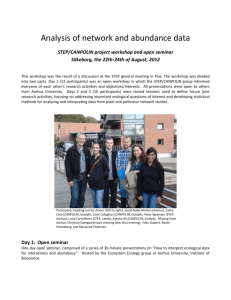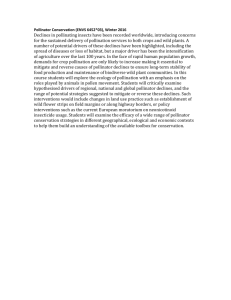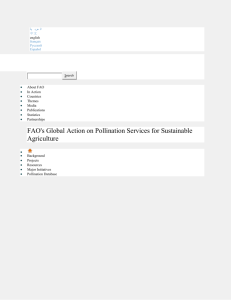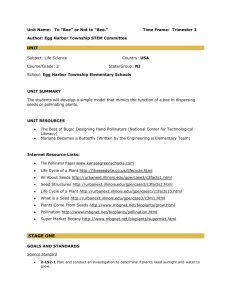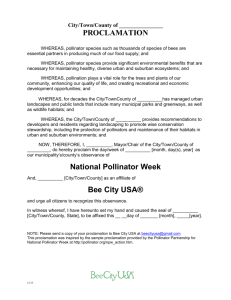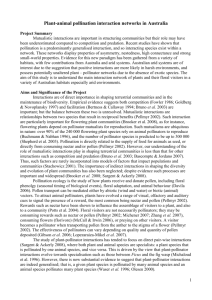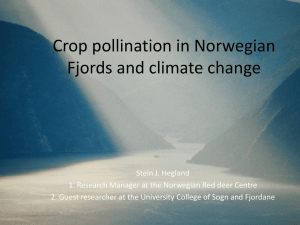STEP/CANPOLIN project workshop and open seminar Silkeborg
advertisement
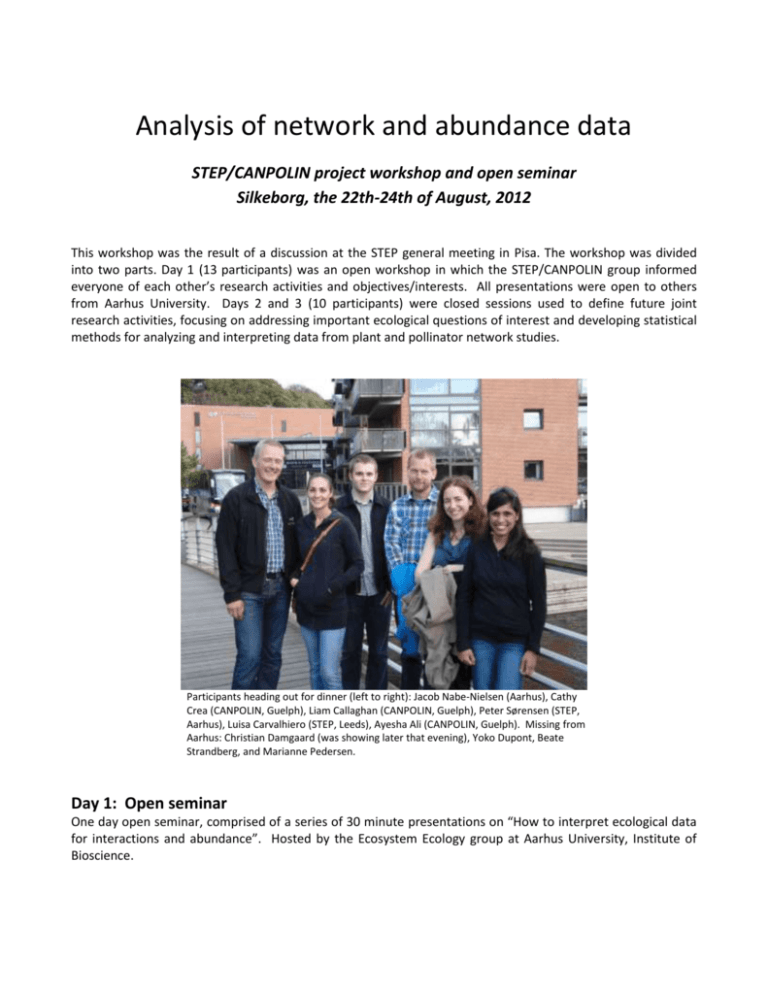
Analysis of network and abundance data STEP/CANPOLIN project workshop and open seminar Silkeborg, the 22th-24th of August, 2012 This workshop was the result of a discussion at the STEP general meeting in Pisa. The workshop was divided into two parts. Day 1 (13 participants) was an open workshop in which the STEP/CANPOLIN group informed everyone of each other’s research activities and objectives/interests. All presentations were open to others from Aarhus University. Days 2 and 3 (10 participants) were closed sessions used to define future joint research activities, focusing on addressing important ecological questions of interest and developing statistical methods for analyzing and interpreting data from plant and pollinator network studies. Participants heading out for dinner (left to right): Jacob Nabe-Nielsen (Aarhus), Cathy Crea (CANPOLIN, Guelph), Liam Callaghan (CANPOLIN, Guelph), Peter Sørensen (STEP, Aarhus), Luisa Carvalhiero (STEP, Leeds), Ayesha Ali (CANPOLIN, Guelph). Missing from Aarhus: Christian Damgaard (was showing later that evening), Yoko Dupont, Beate Strandberg, and Marianne Pedersen. Day 1: Open seminar One day open seminar, comprised of a series of 30 minute presentations on “How to interpret ecological data for interactions and abundance”. Hosted by the Ecosystem Ecology group at Aarhus University, Institute of Bioscience. Presentation Schedule: Liam Callaghan and Ayesha Ali, Modelling plant-pollinator interactions with mixtures of linkage rules In a given ecosystem, there may be several mechanisms (linkage rules) that facilitate observed interactions between plant-pollinator pairs. Hence, pollination networks should be modeled as a mixture of such linkage rules. We propose Latent Dirichlet Allocation (LDA) from artificial intelligence to model the observed interactions in an ecosystem as a mixture of (latent) interaction groups. Each group represents individual pollinators whose interactions are driven by particular linkage rules. Each pollinator species is comprised of a mixture of such individuals. In this talk, we discuss LDA in the context of using pollination webs and we present results from a simulation study that shows LDA works well for compartmental webs, but loses accuracy as nestedness increases. We also demonstrate LDA on real data. Catherine Crea and Ayesha Ali, A Bayesian model for incorporating plant and pollinator traits in mutualistic networks Recent studies have suggested that the structure of plant-pollinator networks is driven by two opposing theories: neutrality and linkage rules. However, relatively few studies have exploited both theories in modeling pollination webs. We propose Dirichlet-multinomial (DM) regression from econometrics for estimating the contribution of each process to network structure. In particular, plant-pollinator interactions are modeled as a function of species abundances, complementarity of traits and barriers to exploitation. DM regression can model different levels of heterogeneity through an over-dispersion parameter. In this talk, we demonstrate DM regression on simulated pollination webs and evaluate its ability to model mutualistic networks. Luisa Carvalhiero, Using historical collections of records to extract patterns of change in plant-pollinator communities Several international and national agreements aim to halt loss of species and declines in biodiversity, investment in pollinator-friendly management measures having considerably increased in the past years. However, information on plant-insect communities prior to 1990 comes mostly from historical databases of records collected haphazardly. Therefore, assessing how plant and animal communities have changed through time is difficult given the dispersed and incomplete nature of historic data and the lack of suitable methods for careful comparisons of species richness and community composition. The existent extensive databases of historical records of species occurrence provide a unique opportunity for the study of biodiversity dynamics. Our current research applies analytical methods that cope with the unstandardized nature these databases, to evaluate how flower visitors (Bees, Hoverflies and Butterflies) and plants that depend on them for pollination are changing through time and space. Yoko L Dupont, Temporal and spatial dynamics in plant-flower-visitor networks. Pollination networks are often analyzed as static entities, for instance a pollination matrix typically consists of observed interactions across an entire season at a specific site. However, networks are highly dynamic. Temporally, species and interactions will change through a season (sometimes even from day to day). Spatially, flowers may be unevenly distributed, and the spatial range of a pollination network may not reflect the foraging ranges of the flower-visiting animals. In this talk I will present some of these temporal and spatial dynamics, and discuss challenges in the analysis of dynamic pollination networks. Jacob Nabe-Nielsen, Modelling how the spatial distribution of plants affects the strength of plant-pollinator associations Cross-pollination is important for the seed-set in many plant species, yet we know only little about how pollinators decide whether to fly between conspecific plants. The aim of this presentation is to demonstrate how agent-based models allow us to decide which strategies insects might use for selecting which plants to visit. A model that is able to reproduce several patterns that can be observed in nature, such as spatial and temporal variations in plant-pollinator associations, is likely to incorporate a realistic decision-making strategy. Possible strategies include minimizing flight distances or maximizing net energy intake. If insects aim to maximize the net energy intake the chance that they fly between conspecifics depends on the spatial distribution of the plants, and the strength of the plant-pollinator associations can then be modelled in different spatial contexts. Toke T. Høye, Eric Post, Niels M. Schmidt, Kristian Trøjelsgaard & Mads C. Forchhammer, Shorter flowering seasons and associated pollinator declines in a warmer Arctic Advancing phenology in response to global warming has been reported across biomes, raising concerns about the temporal uncoupling of trophic interactions. Concurrently, widely reported pollinator declines are linked to resource limitations. Phenological responses in the Arctic have been shown to outpace responses from lower latitudes and recent studies suggest that differences between such responses for plants and their pollinators could be particularly pronounced in the Arctic. The evidence for phenological uncoupling is scant because relevant data sets are lacking or not available at a relevant spatial scale. Here, we present evidence of a climate-associated shortening of the flowering season and a concomitant decline in pollinator abundance based on a comprehensive, spatially replicated, long-term (1996–2009) data set from high-arctic Greenland. The shortening of the flowering season arose through spatial variation in phenological responses to warming. The shorter flowering seasons may have played a role in the observed decline in pollinator abundance. Our results demonstrate that the dramatic climatic changes currently taking place in the Arctic is strongly affecting individual species and ecological communities with implications for trophic interactions. Beate Strandberg, Hayfields – floral resources and pollinators Grasslands have long been recognized for their provision of ecosystem functions (e.g. quality feed, animal health, product quality, soil fertility) and services (environmental benefits, carbon storage and recreational value, pollination). However, the fields on farms are often large and the biodiversity is low. The on-going project, EcoServe, aims at investigating the potential of organic grasslands with a high proportion of herbs to provide a significant better habitat for pollinating insects, and in particular, well-managed hayfields with species flowering during the entire growing season. Marianne B Pedersen, Influence of pesticides on wild bees Last year we performed a preliminary study on two locations with high and low input of pesticides, respectively. Other factors were assumed not to differ significantly. Pesticide exposure was measured twice on bumblebees by sampling bees from previously unexposed hives that we had placed on the two locations. Bumblebee fitness was estimated by weighing the hives several times in the period from May to August. Furthermore, the wild bee fauna was estimated by counting in white clover fields. No clear pattern in pesticide exposure was found, whereas the wild bee fauna of the presumably less exposed site was significantly more diverse and abundant. Hence, no clear connection between exposure and fitness could be established. We assume that landscape differences other than pesticide exposure were responsible for the documented differences in wild bees. Christian F Damgaard, Estimating the spatial aggregation of plants using pin-point cover data The importance of taking the spatial aggregation of plant species into account when analyzing species cover data is demonstrated in case-studies of pin-point cover data. The pin-point cover data was analyzed using a generalised binomial distribution (or Pólya-Eggenberger distribution). Peter B Sørensen, We need better data collection! Data for pollination networks is “just” detailed data of abundance, where the time and location is known for all individual records. Pollination networks comes out when the abundance for the pollinator is combined with the abundance of the flower species. Thus: if an individual pollinator is registered at the same position as a flower species then a “visit” was taking place. The traditional way of getting data is manually to observe pollinator visits of flowers yielding a highly precise identification of single visits. However, the time consumption is high and the number of recorded visits tends to be low. This talk will challenge two myths: (1) “Any data record in the data collection needs to be highly certain in the identification of species” (2) “The data collection is an activity that takes place before modeling of the data”. New technology and an integrated data/modeling approach will be suggested as the next step before real improvements of network modeling will become possible. Day 2: Brainstorm session Participants formulated a list of key scientific questions of interest based on past research done and intended future direction of research. Available data sets amenable to addressing those questions and potential statistical methods to analyze the data were discussed. The list of questions was then prioritized. Day 3: Looking ahead Based on the discussion of the previous day, a short list of potential papers was made. Each paper was assigned to a leader and was discussed in turn by everyone. Ways to facilitate future communication between participants were discussed and a list of tasks for everyone to complete after the workshop was also completed. The workshop was deemed a total success by all and participants left feeling motivated and inspired. A definite synergy between STEP and CANPOLIN was realized here.
